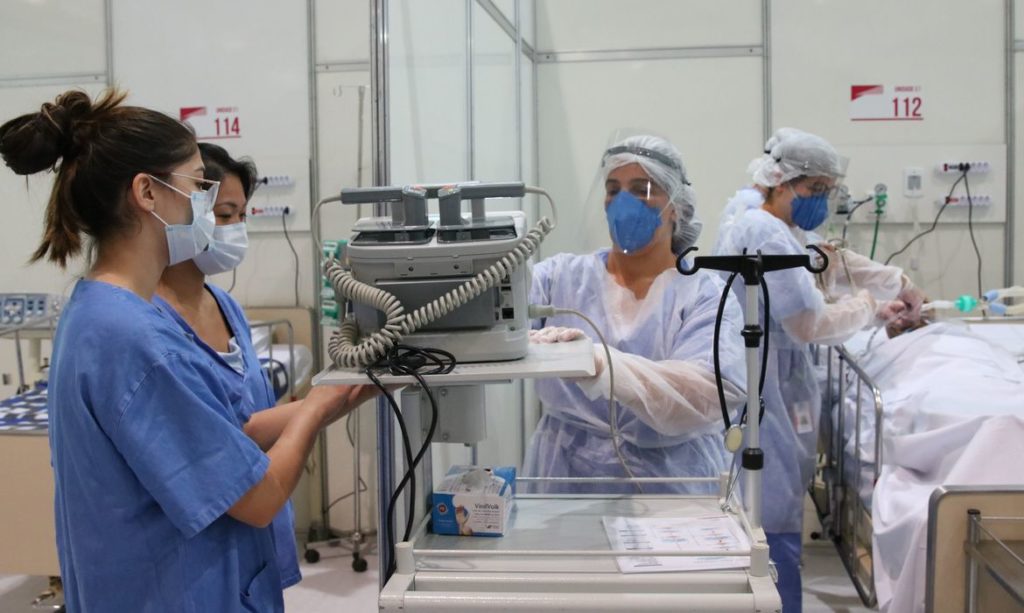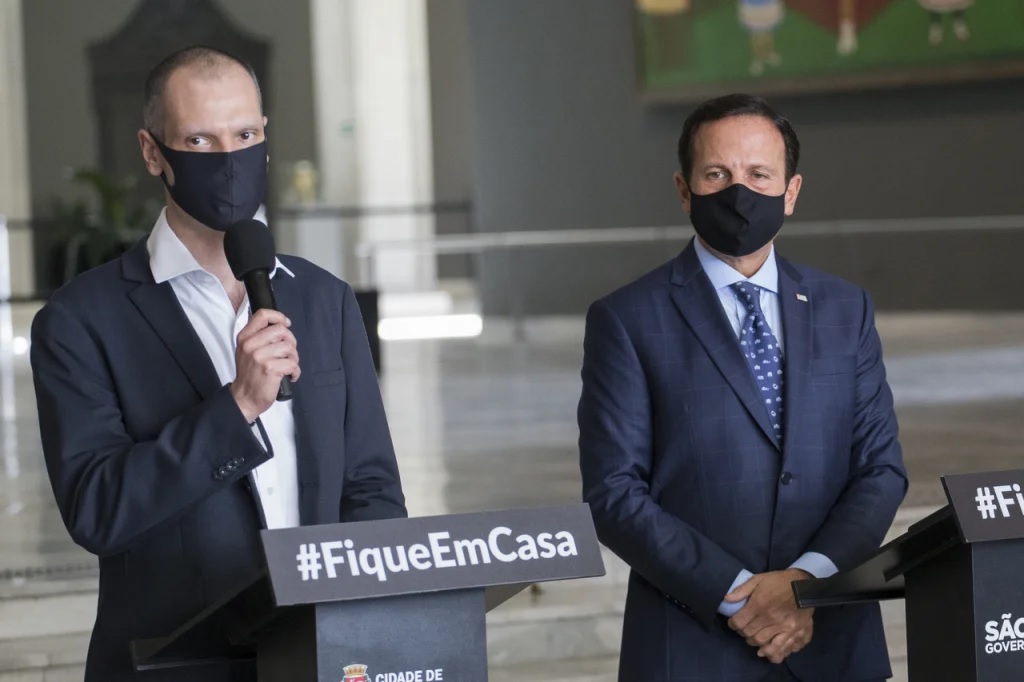RIO DE JANEIRO, BRAZIL – After the rise in the number of hospitalizations and coronavirus cases in the state, the São Paulo government announced on Thursday, November 19th, that it will sign a decree determining that hospitals must not remove beds exclusively intended for Covid-19 patients.
In addition, the new schedules for elective surgeries for other diseases will also be suspended, namely cases that are not considered emergencies. The procedures had been resumed in recent months when the Covid-19 indicators dropped.
“This increase in the [hospitalization] curve reinforces the need for strategic measures. Therefore, the government today signed a decree that orders all public, philanthropic and private hospitals not to remove any bed, be it an ICU or ward bed, for Covid-19 care. As well as not scheduling new elective surgeries, so that we can guarantee beds for all Covid patients,” said the State Health Secretary Jean Gorinchteyn.

In a press conference held earlier on Thursday, the City Hall denied that the city is facing a new wave of Covid-19, but said it opened 200 new beds to treat mild cases of the disease.
Mayor Bruno Covas conceded to an increase in ICU occupancy but said more restrictive measures such as a lockdown were not required.
Quarantine restrictions
After criticism for freezing the classification of the São Paulo Plan, which defines harsher or milder quarantine rules, the government also decided on Thursday to conduct the assessment again every 14 days, and no longer every month.
“The period of one month was adequate in the downward curve, but as we now had two consecutive weeks with increased hospitalizations we are now going to monitor the classification every 14 days. If this trend is maintained, indicators will demonstrate it and we will need to adopt more restrictive measures,” said Economic Development Secretary Patricia Ellen.
Currently, the 39 cities of Greater São Paulo are officially in the green phase of the São Paulo Plan. But, this week, the region is showing Covid-19 epidemic indicators compatible with the more restrictive yellow phase, due to the worsening of the disease in the capital, in the municipalities in the Greater São Paulo East and North sub-regions.
According to Patricia Ellen, if the reclassification had taken place on November 16th, eight regions in the state would have moved from yellow into the green phase.
“The worsening of hospitalization indicators coupled with the instability of federal government data that did not allow us to have a clear picture of the variation of cases and deaths were the two reasons that prompted us to make the decision to defer reclassification. It was a measure of prudence. If we had conducted the classification on November 16th, with the data from that date, we would have taken eight regions to the green phase. The measure was taken precisely because we observed the first indications of a resurgence.”
Increased hospitalizations
On Monday, November 16th, the state administration conceded to an 18 percent increase in hospitalizations of suspected and confirmed cases of the disease in the last epidemiological week, which ran from November 8th to 14th, compared to the preceding week: the daily average of new hospitalizations rose from 859 to 1,009.
Earlier, despite the alert from private hospital doctors in the capital and official data already pointing to an increase in Greater São Paulo, the government denied that the disease was on the rise in the state.
On Thursday, November 19th, Gorinchteyn stated that the state government is still struggling to interpret the data on hospitalizations. He mentioned the instability in the Ministry of Health’s Sivep-Gripe system, which prevented the disclosure of data between November 6th and 10th and also the October 12th holiday, when employees work on call and there is a reduction in the entry of information into the system.
“Our challenge in interpreting the data is due to the fact that we had the holiday week and between the 45th and 46th week we were then surprised by a technical issue, which ran until two days ago when the data began to be gradually introduced. We couldn’t understand if it was a backlog of data which therefore increased the figures or if they had indeed increased and by how much they increased, as these data are also being gradually inserted,” said Gorinchteyn.
According to the Secretary of Health, on Thursday there was an eight percent increase in hospitalizations in the epidemiological week. However, the data are not yet final, since the epidemiological week runs from November 15th to 21st.

Increased occupancy in the capital
The occupancy rate of ICU beds in municipal hospitals in the city of São Paulo by Covid-19 patients reached 48 percent on Wednesday, November 18th. The figure is the highest registered since August 10th, when the occupancy rate in city hospitals stood at 50 percent.
This occupancy rate grew by 15 percent over the past seven days, compared to the preceding seven days. Between November 5th and 11th, the average ICU occupancy rate was 34 percent. Between November 12th and 18th, the average increased to 39 percent. The estimates were based on data released daily by the Municipal Health Secretariat (SMS).
In hospitals outsourced by the City Hall – which are private hospitals with beds rented by the municipal government since May – the increase was even higher: 45 percent. Over the past seven days, the average occupancy rate stood at 48 percent. In the preceding seven days, it had been 33 percent.
ICUs crowded in private hospitals
São Paulo capital patients are struggling to secure ICU beds in private hospitals. According to reports, the increase in the number of coronavirus hospitalizations would be the reason for crowding in the city’s private network.
Relatives of patients say that they could not access beds on Wednesday, November 18th, in at least three major hospitals in the city: Albert Einstein, Sírio-Libanês, and São Luiz.
The problem affects both patients with suspected or diagnosed Covid-19 and other diseases.
In a note, the Israeli Albert Einstein Hospital did not confirm the lack of beds, but said that at the moment “there are 91 beds occupied by patients with confirmed Covid-19 diagnosis” and that “from the last week of September to November 12th, the average hospitalization ranged between 50 and 55 patients with the new coronavirus.”
Doctors working in São Paulo’s private and municipal hospitals also confirm the saturation of the private network. A doctor revealed that on Tuesday, November 17th, in six hours on duty at a private hospital in the West Zone, he attended at least 25 patients with suspected or confirmed Covid-19 symptoms.
In addition to the shortage of beds, private hospital staff is being advised to double the criteria for releasing the few remaining beds, mainly in the ICU.
According to the Brazilian Association of Diagnostic Medicine (ABRAMED), the demand for Covid-19 tests has increased by 30 percent in the past 15 days. The percentage of positive results increased by 25 percent over the same period.
Concerned doctors
In a letter released on Wednesday, November 18th, to relatives and friends, a group of infectologists from several hospitals in the capital said they were “exhausted and surprised” by the increase of Covid-19 cases in the city.
“We believe that you are tired of all this, but remember that we are much more,” they say. “Everyone has to do their part because we, although exhausted, will not stop doing ours,” say the doctors.
Marcela Capucho, one of the signatories to the letter, says that the group was surprised by the number of crowded ICUs and wards in São Paulo with cases of coronavirus infection.
“What happened was that for two weeks, cases began to increase exponentially. We noticed an increase in the number of cases, mainly in the Emergency Room. Wards began to become full again and so did ICUs”, says Capucho in an interview to TV Globo.
“We were a little startled because we didn’t expect this. It’s still a reflection of what’s been happening in society as a whole. That people basically lost their fear and began to go out more on the street, began to expose themselves, began to party… We see people holding wedding celebrations. This would invariably lead to an increase in the number of cases,” says the doctor.
Source: G1

